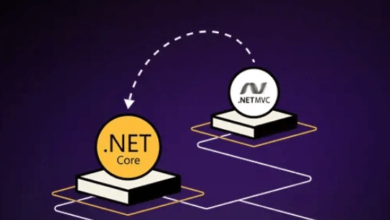Understanding the Basics of the .NET Framework: A Beginner’s Guide

The .NET Framework is one of the most powerful and widely used platforms for building applications, ranging from simple desktop tools to large-scale enterprise systems. If you’re new to software development or looking to expand your programming knowledge, understanding the .NET Framework is a great place to start.
In this beginner’s guide, we’ll explore what the .NET Framework is, why it’s so popular among developers, and how it supports the creation of various types of applications. By the end of this article, you’ll have a solid foundation to start your journey into .NET development.
1. What is the .NET Framework?
The .NET Framework is a software development platform created by Microsoft. It provides a comprehensive environment for building, deploying, and running various types of applications, such as web, desktop, mobile, and cloud-based applications. The framework includes a large class library, language interoperability, and a runtime environment known as the Common Language Runtime (CLR).
In simple terms, the .NET Framework acts as a bridge between your code and the computer’s hardware, allowing developers to write applications that run seamlessly on different Windows environments.
See also: scripthookvdotnet
2. Why is .NET Framework Popular Among Developers?
The .NET Framework is popular because of its robust architecture, extensive support, and ease of use. Some key reasons why developers choose .NET include:
- Language Interoperability: Supports multiple programming languages like C#, VB.NET, and F#.
- Scalability: Ideal for small projects and large enterprise applications alike.
- Cross-Platform Support: With the introduction of .NET Core and .NET 7, applications can run on Windows, macOS, and Linux.
- Extensive Libraries: The framework includes a rich set of pre-built libraries for common tasks like file I/O, data access, and cryptography.
3. The Evolution of .NET: From .NET Framework to .NET Core and .NET 7
Initially, the .NET Framework was limited to Windows-based applications. However, with the introduction of .NET Core, Microsoft made the platform open-source and cross-platform. In 2020, Microsoft unified its frameworks into .NET 5 (now succeeded by .NET 7), streamlining development for web, mobile, desktop, and cloud applications.
4. How the .NET Framework Works
Common Language Runtime (CLR)
The CLR is the heart of the .NET Framework. It handles memory management, exception handling, garbage collection, and security. When you write .NET code, the CLR manages its execution, ensuring efficient use of system resources.
.NET Framework Class Library (FCL)
The FCL provides a vast library of reusable code components, including classes, interfaces, and value types that support various programming tasks such as data access, networking, and GUI development.
5. Key Features of the .NET Framework
- Cross-Language Compatibility: Write code in multiple languages and compile them into a single application.
- Garbage Collection: Automatically manages memory, freeing up resources that are no longer in use.
- Security: Provides robust features like code access security and encryption.
- Debugging and Exception Handling: Built-in tools for detecting and fixing errors during development.
6. Types of Applications You Can Build with .NET Framework
Desktop Applications
Use Windows Forms and WPF (Windows Presentation Foundation) to create rich desktop applications.
Web Applications
Build dynamic web apps using ASP.NET and Blazor.
Mobile Applications
Develop mobile apps for Android and iOS using Xamarin.
Cloud Services
Leverage Azure cloud services to deploy scalable applications.
7. Understanding the .NET Framework Architecture
Managed Code vs. Unmanaged Code
- Managed Code: Code that runs under the supervision of the CLR.
- Unmanaged Code: Code that runs directly on the operating system without CLR support.
Intermediate Language (IL)
When you compile a .NET application, the source code is translated into Intermediate Language (IL), which is then compiled into machine code by the JIT (Just-In-Time) Compiler at runtime.
8. Popular Programming Languages Supported by .NET
- C#: The most popular language for .NET development.
- VB.NET: Ideal for legacy applications and business solutions.
- F#: A functional-first programming language suited for data analysis and scientific computing.
9. Getting Started with .NET Development
To start developing with the .NET Framework:
- Download Visual Studio: The most popular Integrated Development Environment (IDE) for .NET.
- Install the .NET SDK: This includes all the tools you need to build .NET applications.
- Create a New Project: Use templates to quickly get started with your desired application type.
10. Common Tools and IDEs for .NET Development
- Visual Studio: The go-to IDE for .NET development, offering powerful debugging, code completion, and design tools.
- JetBrains Rider: A cross-platform IDE that’s great for .NET Core projects.
- Visual Studio Code: Lightweight, open-source editor for quick coding and debugging.
11. Advantages and Limitations of the .NET Framework
Advantages:
- Easy to learn and widely supported.
- Built-in security features.
- Robust error handling.
- Large community and resources for learning.
Limitations:
- Windows-centric (though this is changing with .NET Core and .NET 7).
- Heavy for small-scale projects.
- Some older features are no longer actively supported.
12. Future of the .NET Framework
The future of .NET lies in .NET 7 and beyond, where Microsoft is focusing on performance enhancements, cross-platform capabilities, and cloud integration. The .NET ecosystem continues to evolve, with a strong emphasis on open-source collaboration and community-driven innovation.
13. Frequently Asked Questions (FAQs)
Q1. What is the difference between .NET Framework and .NET Core?
The .NET Framework is Windows-only, while .NET Core (now unified under .NET 7) is cross-platform and open-source.
Q2. Can I build mobile apps with the .NET Framework?
Yes, using Xamarin or .NET MAUI, you can build cross-platform mobile applications.
Q3. Is .NET a good choice for beginners?
Absolutely! .NET is beginner-friendly, with extensive documentation, a supportive community, and powerful development tools.
Q4. How do I choose between .NET Framework and .NET Core?
Choose the .NET Framework for legacy Windows apps and .NET Core/.NET 7 for new, cross-platform projects.
Q5. What programming languages can I use with .NET?
Common languages include C#, VB.NET, and F#, but .NET also supports Python, JavaScript, and others through extensions.
Q6. Can I run .NET applications on Linux?
Yes, .NET Core and .NET 7 support Linux, making .NET truly cross-platform.
Conclusion
Understanding the basics of the .NET Framework is a crucial first step for anyone interested in software development. Whether you’re building desktop applications, web apps, or cloud services, .NET offers a flexible and powerful environment that can cater to a wide range of project needs. As the platform evolves with .NET 7, now is the perfect time to dive into the world of .NET development.
Whether you’re a beginner or an experienced developer, mastering the .NET Framework will open up new opportunities and help you build efficient, scalable applications for the future.



